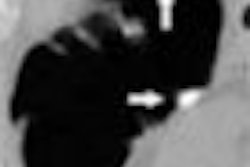With the higher spatial resolution enabled by multidetector computed tomography (MDCT), radiologists can identify many more nodules in a lung scan than they could with earlier technology. But working through all those thin-slice images is also a recipe for reader fatigue.
Computer-aided detection (CAD) systems are impervious to fatigue, of course, which is one reason why they may warrant a role in plowing through the immense datasets generated by MDCT. And research also confirms that, in looking for nodules missed by a first reader, CAD systems do a better job than a second radiologist.
"CAD finds different things from radiologists, and that's why it's a better partner for radiologists than another radiologist," noted Dr. Geoffrey D. Rubin, chief of cardiovascular imaging at Stanford University and lead author of a newly published study on the subject (Radiology, January 2005, Vol. 234:1, pp. 274-283).
"What this study shows is that CAD has the potential to substantially increase the sensitivity of radiologists for detecting pulmonary nodules in MDCT data," Rubin said in an interview with AuntMinnie.com.
The CAD software used in the study was a noncommercial system developed at Stanford, Rubin said.
As an aside, the Stanford study also highlights the mixed blessing created by MDCT's superior detection capability: It can illuminate an even more daunting number of findings in just a single patient.
The researchers re-examined the scans of just 20 patients who had been referred for MDCT due to clinical suspicion of pulmonary nodules. Yet among those 20 patients, the radiologists and CAD system generated some 1,297 "detections."
The Stanford team conducted an extensive expert-consensus review process to determine which of those detections were actually nodules -- a process necessitated by the lack of an alternative gold standard, Rubin said.
"One of the limitations of virtually all papers published on CAD of the lung is the reference standard," he said. "We really sought to take a fresh approach at creating the reference standard from a very rigorous standpoint."
The expert panel concluded that there were 936 false-positives among the 1,297 detections, including peripheral vessels (62% of the false-positive findings), amorphous parenchymal opacities (24%), airway walls (7%), scan artifacts (4%), and central vessels (3%).
There were 327 true nodules among the detections, including the 195 noncalcified nodules larger than 3 mm that composed the basis for evaluating reader performance.
The number of significant nodules per patient ranged from a low of zero to a high of 65. More than half of the nodules were smaller than 5 mm in diameter.
The mean sensitivity of individual readers in identifying these significant nodules was 50%; the addition of a second radiologist had the potential to improve that to a mean of 63%.
Use of CAD as a second reader improved the sensitivity to 76% with just three additional false-positives. Even higher sensitivity could be achieved if more false-positives were allowed.
"Going from 50% up to 76% at a minimum is a huge jump," Rubin said. "But to get to the point where I could advocate that a clinical site use CAD, we need more data."
Also, Rubin noted, while MDCT with CAD can greatly improve the detection of nodules -- especially those that are smaller and therefore more potentially treatable if they are cancerous -- the challenge of determining which nodules are truly dangerous remains.
"We know that the vast majority of them will have no significance whatsoever to the patients," Rubin said. "It's just finding the proverbial needle in the haystack."
By Tracie L. Thompson
AuntMinnie.com staff writer
January 12, 2005
Related Reading
Ultra-low-dose CT lung scan shows high accuracy at chest film dose, December 13, 2004
Lung CAD makes strides in nodule detection, January 30, 2004
Lung CAD applications starting to outread radiologists, February 13, 2003
Copyright © 2005 AuntMinnie.com




















